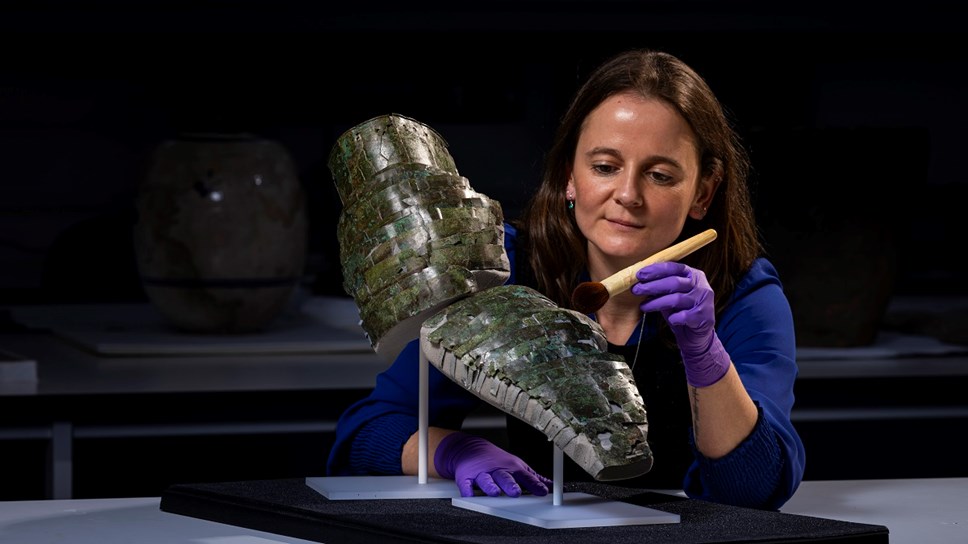
Ancient jigsaw puzzle is solved as rare Roman armour is reconstructed ahead of major exhibition
An exceptionally rare piece of Roman armour from National Museums Scotland’s collection has been painstakingly reconstructed from dozens of fragments. Dating from the middle of the second century, the brass arm guard will be seen in its entirety for the first time in almost 2000 years when it goes on loan to the British Museum for the major exhibition Legion: life in the Roman army next month.
Press images and a video of a curator discussing the Roman arm guard can be downloaded here
Conservators in Edinburgh spent weeks rebuilding the arm guard, which is the most intact example of its kind and one of only three known from the whole Roman Empire. The armour was discovered in over 100 pieces at the site of the Trimontium fort near Melrose in 1906. It is in remarkably good condition, with remnants of leather straps still attached to the metal.
The fragments have been in National Museums Scotland’s collection for over a century. The upper section has been on display in the National Museum of Scotland for 25 years, with the lower section loaned to the Trimontium Museum and dozens of fragments stored at the National Museums Collection Centre. They have now been brought together and assembled for the first time, offering a glimpse into the life of a legionary in Roman Scotland. Following the exhibition at the British Museum, the arm guard will go on permanent display at the National Museum of Scotland.
Dr Fraser Hunter, Principal Curator of Prehistoric & Roman Archaeology at National Museums Scotland, said:
“This is an incredibly rare object, and it’s great that this exhibition gave us the opportunity to rebuild it. The transformation is striking. Now that it’s been reconstructed, you can picture the legionary who once wore it. It was both protection and status symbol – brass was expensive and would have gleamed like gold on his sword arm. It offers a vivid connection to this important period when Scotland sat on the Roman Empire’s northern frontier.”
Bethan Bryan, Assistant Artefact Conservator at National Museums Scotland, said:
“It’s been a privilege to work on such an extraordinary piece of Scotland’s history. Approaching this ancient jigsaw puzzle required careful consideration and it was important to make sure we could display the piece in a manner as near as possible to how it would have looked 2000 years ago. I’m thrilled that it can now be seen by audiences in a new light and has been preserved for generations to enjoy.”
The arm guard stretches down from the shoulder and ends in a thin square of metal that would have protected the wearer’s hand, a design that may have been inspired by the equipment worn by gladiators fighting in the arena. Experts initially believed it would have been body armour, and it was later thought to be a thigh guard for a cavalryman. It is only in recent years that its true function has been understood.
Legion: life in the Roman army (1 February – 23 June 2024) is a major new exhibition at the British Museum that will examine the reality of daily life within one of the most elite fighting forces of all time.
Richard Abdy, Curator of Roman and Iron Age coins at the British Museum, said:
“It’s a splendid privilege to premier the National Museums Scotland armoured sleeve for the British Museum’s exhibition. The flexible armguard is an iconic piece of equipment for Roman gladiators, so it is unusual to see it as a sword-arm protection for Roman soldiers too. Its display, posed with classic legionary segmental body armour, is stunning. The latter is also possibly derived from gladiator kit and we even think that the training regime for the amphitheatre originally inspired combat training of the professionalising Roman army. The image of Roman soldiers and gladiators appropriately unite in one artefact – two characteristic strands of the dark side of Roman civilisation that have long fascinated public imagination.”
Through loans and touring exhibitions, National Museums Scotland is committed to bringing the National Collection to new audiences across Scotland, the UK and internationally, engaging those around the world with Scotland’s story.
Notes to editors
- National Museums Scotland is one of the leading museum groups in the UK and Europe and it looks after collections of national and international importance. The organisation provides loans, partnerships, research and training in Scotland and internationally. Our individual museums are the National Museum of Scotland, the National Museum of Flight, the National Museum of Rural Life and the National War Museum. The National Museums Collection Centre in Edinburgh houses conservation and research facilities as well as collections not currently on display.
Twitter: @NtlMuseumsScot
Facebook: www.facebook.com/NationalMuseumsScotland
Instagram: @NationalMuseumsScotland
2. Bheireadh Oifis nam Meadhanan eadar-theangachadh Gàidhlig den bhrath-naidheachd seachad do bhuidhinn mheadhanan bharantaichte. Cuiribh fios do dh'Oifis nam Meadhanan airson bruidhinn air cinn-latha freagarrach.
